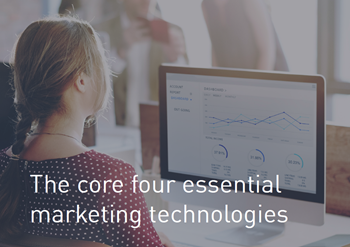For marketers, this means harnessing advances in software development to deliver greater personalization and seamless user journeys. As a result, monolithic legacy systems have demonstrated some limitations in allowing businesses to effectively pivot in order to maintain momentum. The inability to accommodate necessary and quick changes to the user experience or effectively scale to meet demands could be costly.
To avoid this, business leaders must look beyond the classic, monolithic applications to a modern headless, microservices-based technology to power digital customer experiences. Around this need, the concept of MACH architecture has grown.
MACH stands for:
- Microservice - Single pieces of functionality that can be individually designed/deployed, leading to faster development and release cycles and quicker updates
- API-first - Enabling the flow of data between microservices
- Cloud-native - For on-demand access and unrivaled scalability
- Headless - The ability to deliver amazing front-end experiences without the distraction of back-end architectures, freeing you up to respond rapidly to changing market conditions
MACH-architected platforms focus on what can be called ‘composable’ architecture, facilitating business agility by offering leaders the chance to take a more modular, best-in-class approach.
The increasing value of this approach has been borne out in several studies and reports, including one from Gartner, which predicts that: “By 2023, organizations that have adopted a Composable Commerce approach will outpace the competition by 80% in the speed of new feature implementation”.
The potential of composable architecture
Each factor in MACH enterprise architecture is designed to make it quick and easy to change and update your platform. The ability to pivot and adjust quickly allows brands to be more responsive and agile and to make changes without having to wait for major updates to their existing suite solutions. Businesses that include MACH principles in their digital platforms can become future-proof - something we’re all striving after in times of unprecedented disruption.
Take manufacturing as an industry example; these were firms that were fine-tuned for the 20th century economy which rewarded the efficiencies of scale and the globalization of the supply-chain.
Their market position now depends on their ability to transform their business at speed. They’re racing to become more agile, responsive and adapted to continuous changes and market competition. They’ll need to embrace new digital capabilities and harness tools that will enable them to deliver better customer experiences and improve business operations, from empowering sales reps with the insights and capabilities to better respond to customer needs, to developing a more versatile supply chain more in line with how customers are consuming services and products.
Applying MACH principles
When we apply a MACH approach to those challenges, the introduction of microservices means faster deployment times and a removal of legacy technology dependencies. Cloud hosting means the ability to scale at pace, adding new sites, systems and functionality without slowing everything else down in the process.
By decoupling the front and back-end technologies, brands can enable their teams to respond faster to changing market conditions and to deliver a UX that maximizes conversion. It’s this ability to make connections between traditionally siloed streams of the business, like CRM, data and commerce that gives brands the power to see what’s really going on in their business and be much more intuitive in their response.
In times of disruption or rapidly changing market conditions, you need tools and technologies that will enable you to make better business decisions faster, to continuously innovate and to incorporate continuous feedback to drive better outcomes.
Levi’s is a real world example of this in action, and shows the value of adapting in line with changing customer habits. Working with Valtech, Levi’s leveraged MACH architecture to build an international in-store digital experience.
Building on Connected Experience principles and MACH technologies, Valtech and Levi’s delivered an in-store tailoring service that took the store from a simple space to a memorable and emotive experience.
By combining digital with physical spaces, we unlock the brand potential from both directions – physically immersing our customers into a space that we can tailor to live and breath the brand, whilst giving them all of the digital tools to make the experience multidimensional, simple, smart and memorable.
In this sense, MACH architecture can be the glue between physical and digital commerce, driving positive customer experiences and thus improving acquisition and retention of business while combining two previously disparate aspects of commerce. While there will always be a space for traditional brick and mortar stores, ecommerce and mobile commerce surged in 2020, for obvious reasons - and this trend is unlikely to reverse.
As such, physical retailers and brands must provide the composable digital architecture to respond to an increasingly mobile world, while those already in the digital commerce space should re-architect to instil agility, resilience and innovation.
Rethink your business
Valtech is one of the founding members of the MACH Alliance: a group of independent, future-thinking tech companies dedicated to advocating for open, best-of-breed technology ecosystems. The alliance is rooted in the common belief that the interoperability and open architecture of modern software will propel current and future digital experiences.
By forming an alliance with some of the leading firms in the MACH space, we’ll shine a light on the next generation of enterprise architectures and show that there are alternatives available to the traditional suite-solutions.
For brands to be able to scale and respond to disruption—whether that’s a shifting customer trend or a global pandemic—they must rethink their businesses, apply modern approaches and transform by doing.
Access the latest business knowledge in Marketing
Get Access





![Which MarTech Tool Do You Need the Most? [Quiz]](/getmedia/24931c21-841f-4c50-bdcd-2f0724cb5f4b/which-martech-tool-do-you-need-the-most.jpg?maxsidesize=350&resizemode=force)
Comments
Join the conversation...